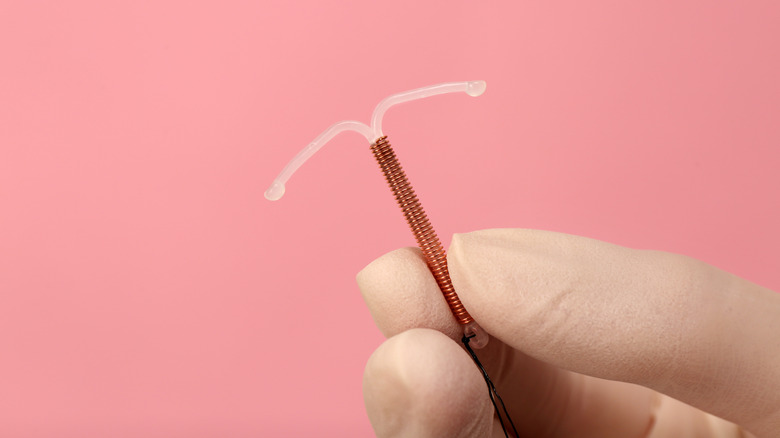How To Speak Up (And Be Heard) About IUD Insertion Pain
When it comes to birth control, intrauterine devices — otherwise known as IUDs — are nothing short of miraculous. With almost-perfect prevention, long-term use, and reversibility, IUDs are medical implants that revolutionized birth control for women. But having the device inserted is another story. Though eager to experience the upsides, some patients dread the insertion procedure, often done without anesthesia, and frequently described as painful. Cosmopolitan reports there is no standard protocol when it comes to pain during IUD insertion, meaning the burden of pain management falls largely on patients themselves. While pain is experienced in different ways by different people, there are some universal ideas that can prepare you for IUD insertion, including preparing to communicate with your doctor. Black patients should be particularly aware that concerns about their pain have been historically taken less seriously than those of white patients.
Should you decide to use an IUD, before anything else, consider the idea that managing your care comes even before the insertion happens. One of the best things to do is to be proactive about the procedure. Get plenty of rest the night before, eat a nourishing meal, and drink plenty of water. Planned Parenthood also recommends taking 800 mg of Advil about 30 minutes beforehand to minimize any potential pain during and after the procedure.
Not everybody experiences a painful IUD insertion. But what happens when you're there, legs in the air, facing excruciating pain?
Documenting procedural pain
Women on TikTok have been recording themselves during IUD insertion to both document the experience and share with others a real-time account of the procedure. TikTok user @haylhaylo posted a video of herself having her IUD placed that has more than 1.9 million views at the time of writing. In it, you can hear her doctor communicating with her about the pain and procedure. "AM I GIVING BIRTH WTF," text flashes across the screen as she winces.
Often, anxieties of the unknown can put us on edge. This is where you can use your voice; having the knowledge of what to expect can put you further at ease. Write down any questions you may have, and before the insertion occurs, talk with your doctor about anything that might be bringing you fear. For example, it is completely within your right to know each step your doctor will be taking throughout the procedure, including what tools they will be using and how they are used. Your doctor can help you come up with a pain management plan ahead of your next procedure, which might be of extra importance for those who have had a negative experience with IUD insertion before. Consider also setting expectations with your doctor about what you want from their communication throughout. Do you want to know precisely what is happening and why? The experience can and should be both as comfortable and informed as possible for you.
The process of IUD insertion
TikTok user Midwifemamma posted a demonstration of an IUD insertion on her page. According to Planned Parenthood, a doctor will first insert a speculum, which expands the walls of the vagina to clearly see the cervix. After identifying the cervix, a doctor will hold it in place using forceps called a tenaculum, which is the double-pronged instrument that pierces the cervix to keep it straight during insertion. The uterus will then be measured for insertion using a small rod called a hysterometer, which can slightly dilate the cervix. While the entire process does not take more than a few minutes, and the actual insertion often takes just seconds, any aforementioned steps can cause pain, and many women have reported feeling unprepared by pain expectations suggested by health providers. One study in The Journal of Family Planning and Reproductive Health Care found that, while 83% of 100 women were happy with their IUDs after about a year following the procedure, 78% experienced "moderate to severe" pain during insertion.
When you feel pain coming on, first, stay calm and breathe. Keeping a clear head will help you to gauge your pain level and communicate concisely with your doctor if need be. Do not be afraid to clearly and directly tell your doctor to stop, should the pain feel overwhelming. You can always reschedule your appointment, and work with your provider to give you the best future care.
Advocating for alternatives
Some are advocating for IUD insertion with anesthetics. Discuss your options with your doctor. One study showed that a topical anesthetic of mixed lidocaine and prilocaine was successful in reducing pain during the procedure. Another study showed that, while lidocaine injections can be painful — and a total of three were administered before insertion — they were effective in reducing both pain and perceived pain. Perceived pain is an important factor when it comes to the procedure: a further study found that, should a patient have fear around IUD insertion and expect to have a negative experience, they are more prone to experiencing higher levels of pain.
While the cervix must be stabilized to ensure that tools used do not perforate the uterus or other organs, alternatives to the tenaculum are being explored, such as the Carevix, a medical tool that uses suction instead of pinching to perform the same function. Though still in its trial phases, results show it could be much less painful.
After the procedure, make sure to also touch base with your doctor about what complications might look or feel like, and when you should return to the office to address them. Some pain and cramping is to be expected in the days or weeks following, but intense pain and significant bleeding is not. Do not hesitate to seek care. Document what you feel. And remember you can seek more than one opinion for any reason at all.

